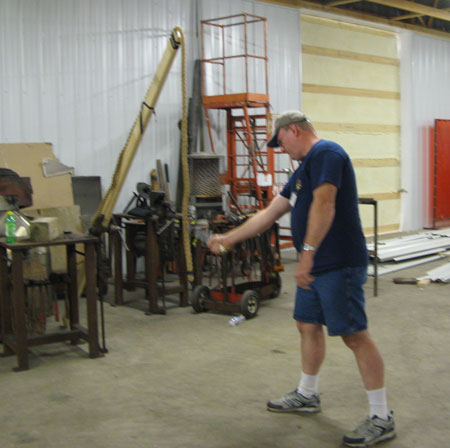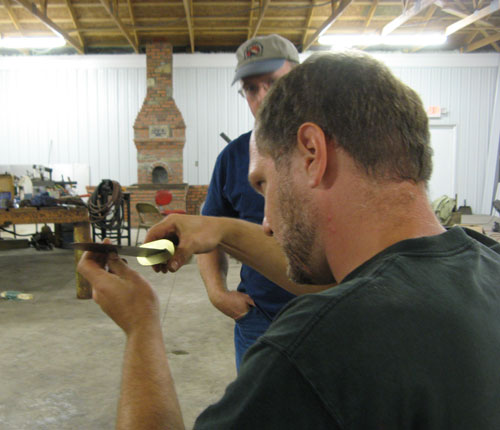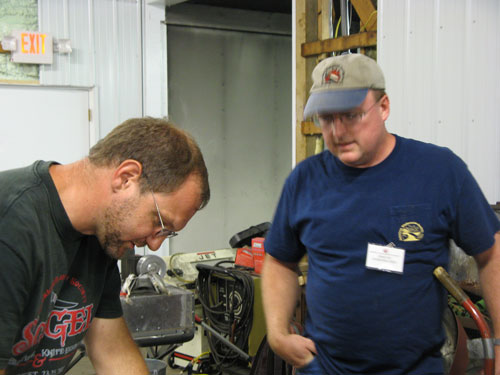Question about Master Smith Performance Test Knife
I was asked a question about the test knife for the Master Smith performance test today and want to share the question and answer with you as well as the ABS rule on this issue.
Question:
Hi Dan
I have a question for you on the requirements for the MS performance blade that came up as I was reading the rules.
The rules state that the knife must be a stick or hidden tang construction. By this definition, is a tang that goes through the handle with a pommel nut on the end of the handle as is done with a takedown knife acceptable?
I assume that it is, but the "hidden" part has me questioning this.
It is mentioned twice in the rules and hidden is in " " marks.
Answer:
The big difference between the Journeyman test and Master’s is that the Journeyman applicant may use a full-tang blade if he wishes, and the Master applicant must use a hidden tang, which is sometimes called a stick tang, rat-tail, etc. If you want to make it a take-down model, that’s just fine. It just has to be a narrow tang that inserts into the handle material and is therefore hidden.
Greg Neely, MS
Chairman, ABS Board of Directors
ABS Rule
ABS Chairman Greg Neely,MS, wrote a series of three articles for the ABS Journal on MS and JS testing and this is the second article in the series of three and focuses on Master Smith testing. The third article was published in the Spring 2009 issue of the ABS Journal.
Assuming that the candidate has held the rating of Journeyman Smith for a period of two years or more, he or she is now eligible to enter the testing phase for Master Smith. The first step, of course, is the physical performance test, probably more commonly known as the "cutting and bending" test. On this occasion, however, the test blade must be made by the applicant of pattern-welded Damascus steel of the applicant's making. The same maximum size requirements are in force - 10 inches maximum blade length from guard to tip, a maximum width of not more than 2 inches, and 15 inches maximum overall length of the knife.
There are a couple of new twists added. The Damascus blade must consist of a minimum of 300 layers. The blade should be lightly etched, just enough so that the Master testing the applicant can see the layers and make a good estimate as to the layer count. The test blade also must be of hidden tang design. If the tang bends over during this test, the applicant does not pass, so I heartily recommend that a rudimentary handle and guard be firmly affixed to the blade, and held in place by at least one metal pin through the handle and tang. This should give enough support and mechanical advantage to prevent the bending of the tang area.
Finish is not important at this stage. The Master may ask you several questions to get a better picture of your knowledge, and he may, if he wishes, point you toward his forge and require you to either forge a blade or weld up a Damascus billet.
Given that the blade passes the performance test, the applicant must provide the testing Master a copy of the ABS form so that he can affix his signature, certifying that the applicant tested and passed on that date. Keep the form and the bent blade in a safe place until you appear in Atlanta (or San Antonio in 2012) and bring both with you to the Board review. You must bring both or you will not be allowed to pass the review! A successful test is good for a period of three years.
Dan Cassidy
Journeyman Smith
Send an email to Dan

Brian Thie Passes the Master Smith Performance Test
Brian Thie took and passed the Master Smith Performance Test at the Mid America Hammer-In in Troy, Ohio on Friday, August 27th under the supervision of Master Smith Kevin Cashen with Master Smith Russ Andrews observing. Brian used a knife that met all of the ABS requirements and had a Damascus blade with more than 300 layers as specified.
Before the test began Master Smith Kevin Cashen inspected the knife and then Brian easily cut through the one (1) inch free hanging rope in one swing. Next Brian cut through two 2x4 wood boards with his Damascus blade. Brian shaved hair off of his arm to show that the edge was still sharp and the blade was again inspected by Master Smith Cashen and was again free of any defect from the testing.
Last, the blade was placed in a vise and Brian bent it 90 degrees without a break or crack in the blade. Brian Thie passed his Master Smith Performance Test and his certificate was signed by Master Smith Cashen. Congratulations!
Dan Cassidy
Journeyman Smith
Send an email to Dan

Congrat's Brian!!!! Best of luck on the judging portion of the test!
Way to go, Brian!
Brian, this is great news. Keep us posted on your journey.
Bing
Thanks guys. I appreciate it.
Brian
ABS YouTube Channel - Brian Thie's Master Smith Performance Test
This is a rare look at video footage of the ABS Master Smith Performance Test. You can see all of the tests administered to challenge the 300 layer Damascus blade that was forged by Brian Thie. This test was supervised by Master Smith Kevin Cashen at the Mid America Hammer-In in Troy, Ohio in August 2010.
[media] http://www.youtube.c...h?v=fWNh6UvE8lA [/media]
Dan Cassidy
Journeyman Smith
Send an email to Dan

Brian, congratulations, great performance test. The video is really good and should be required viewing for aspiring testers. Congratulations again. I look forward to seeing your dagger.
Brion
Brion Tomberlin
Anvil Top Custom Knives
ABS Mastersmith
Excellent!!!! Good job and Congratulations Brian. Lin
Thanks guys!
A big thanks also needs to go out to Dan for putting this together and making it available here on the web site.
Brian
Way to go, Brian.
Guess I'd better catch up.
Karl B. Andersen
Journeyman Smith
|quoted:
There are a couple of new twists added. The Damascus blade must consist of a minimum of 300 layers. The blade should be lightly etched, just enough so that the Master testing the applicant can see the layers and make a good estimate as to the layer count.
Is there a definition of "layer" in writing somewhere?
I know that 3 or 4 pieces of 15N20 in a row do NOT count for 3 or 4 "layers".
But I was party to a conversation where one of the participants was considering calling those pieces EACH a separate layer, which ultimately would end up with the billet being considered a much higher layer count than it actually was.
I was trying to think of where I had ever seen a definition of "layer" but couldn't think of one.
Is there any reference where persons can be referred to, to define the word "layer" as we use it in ABS testing?
Karl B. Andersen
Journeyman Smith
|quoted:
Is there a definition of "layer" in writing somewhere?
I know that 3 or 4 pieces of 15N20 in a row do NOT count for 3 or 4 "layers".
But I was party to a conversation where one of the participants was considering calling those pieces EACH a separate layer, which ultimately would end up with the billet being considered a much higher layer count than it actually was.
I was trying to think of where I had ever seen a definition of "layer" but couldn't think of one.
Is there any reference where persons can be referred to, to define the word "layer" as we use it in ABS testing?
Karl:
I contacted ABS Chairman Greg Neely and posed your question to him and I am attaching his reply.
Dan Cassidy
ABS Webmaster
_____________________________________________________________________________________________________________________________
Reply from ABS Chairman Greg Neely, Master Smith:
Okay, here’s the way it is.
Whereas a double layer of 15N20 or other alloy is unarguably two layers, it cannot normally be seen with the naked eye. When this rule was written, billets were normally all laid up with thicker layers and doubling was uncommon. It was, therefore, easy for anyone inspecting the blade to approximate the layer count with the naked eye. The purpose of the minimum layer count was conceived as a way to assure that a smith was capable of making consistent multiple welds on a billet, and that he or she didn’t just “get lucky†making a minimum number of welds.
It is, therefore, essential that there be enough contrast between layers so that an inspecting Master can readily estimate whether the minimum layer count has been achieved. For this reason, I will have to say that a double layer of the same alloy will be appear to be a single layer in the finished blade, therefore it will only count as a single layer. We trust our bladesmiths; however, this is an examination and we have no way to verify double layers which don’t appear to be anything but a single layer. My recommendation is that a smith try to use materials of sufficient thickness that doubling isn’t necessary for this one blade. Otherwise, multiple pieces of the same alloy stacked together will count as one layer.
Perhaps the wording might be changed to say “contrasting layers†or “layers of contrasting alloys.â€Â
The dagger and the performance test blade are the only blades required to be of 300-layer (minimum) pattern-welded steel construction for the Master’s test.
Thanks,
Greg Neely
Dan Cassidy
Journeyman Smith
Send an email to Dan

Dan, that is a perfect explanation!
"300 layers of contrasting alloy".
Thank you very much.
And Greg is right, the wording should be changed to reflect the materials we more commonly use today, as opposed to the thicker materials used when testing was originated.
His letter could be put in a sticky somewhere.
Karl B. Andersen
Journeyman Smith






